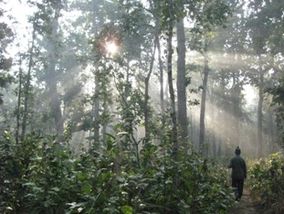Bardiya National Park: Difference between revisions
BhagyaMani (talk | contribs) →History: moved ref name to intro |
BhagyaMani (talk | contribs) intro: described boundaries + ref |
||
| Line 18: | Line 18: | ||
'''Bardia National Park''' is located in the [[Far-Western Region, Nepal]] and was established in 1988 as ''Royal Bardia National Park''. Covering an area of 968 km<sup>2</sup> it is the largest and most undisturbed wilderness area in the [[Terai]], adjoining the eastern bank of the [[Ghaghara River|Karnali River]] in the [[Bardiya District|Bardia District]]. |
'''Bardia National Park''' is located in the [[Far-Western Region, Nepal]] and was established in 1988 as ''Royal Bardia National Park''. Covering an area of 968 km<sup>2</sup> it is the largest and most undisturbed wilderness area in the [[Terai]], adjoining the eastern bank of the [[Ghaghara River|Karnali River]] in the [[Bardiya District|Bardia District]]. |
||
The northern limits of the protected area are demarcated by the crest of the [[Siwalik Hills]]. The [[Nepalgunj]]-[[Surkhet]] highway partly forms the southern boundary, but seriously disrupts the protected area. Natural boundaries to human settlements are formed in the west by the Geruwa, a branch of the Karnali River, and in the southeast by the Babai River.<ref name="mk98">Majupuria, T.C., Kumar, R. (1998) ''Wildlife, National Parks and Reserves of Nepal.'' S. Devi, Saharanpur and Tecpress Books, Bangkok. isbn 974-89833-5-8</ref> |
|||
== History == |
== History == |
||
Revision as of 20:06, 26 March 2010
Bardia National Park is located in the Far-Western Region, Nepal and was established in 1988 as Royal Bardia National Park. Covering an area of 968 km2 it is the largest and most undisturbed wilderness area in the Terai, adjoining the eastern bank of the Karnali River in the Bardia District.
The northern limits of the protected area are demarcated by the crest of the Siwalik Hills. The Nepalgunj-Surkhet highway partly forms the southern boundary, but seriously disrupts the protected area. Natural boundaries to human settlements are formed in the west by the Geruwa, a branch of the Karnali River, and in the southeast by the Babai River.[1]
History
In 1815, Nepal lost this region to the East India Company through the Sugauli Treaty. For 45 years it was a part of British India and returned to Nepal in 1860 in recognition for supporting the suppression of the Indian Independence movement in 1857. Today, this annexed area is still called Naya Muluk - newly acquired land. An area of 368 km2 was set aside as Royal Hunting Reserve in 1969 and gazetted as Royal Karnali Wildlife Reserve in 1976. In 1982, it was proclaimed as Royal Bardia Wildlife Reserve and extended to include the Babai River Valley in 1984. Finally in 1988, the protected area was gazetted as national park.[1]
The approximately 1500 people who used to live in this valley have been resettled elsewhere. Since farming has ceased in the Babai Valley, the natural regenerated vegetation makes the area a prime habitat for wildlife.[1]
Vegetation
About 70% of the park is covered with forest with the balance a mixture of grassland, savannah and riverine forest.[2]
Fauna
The park provides excellent habitat for endangered animals like the rhinoceros, wild elephant, tiger, swamp deer, black buck, gharial, marsh mugger crocodile and Gangetic dolphin. Endangered birds include the Bengal florican, lesser florican, silver-eared mesia and Sarus crane. More than 30 different mammals, over 200 species of birds, and many snakes, lizards and fish have been recorded in the park's forest, grassland and river habitats. A good number of resident and migratory birds are found in the park. It is also the home of two of the last known herds of wild Asian elephants.
References
- ^ a b c Majupuria, T.C., Kumar, R. (1998) Wildlife, National Parks and Reserves of Nepal. S. Devi, Saharanpur and Tecpress Books, Bangkok. isbn 974-89833-5-8
- ^ Dinerstein, E. (1979) An ecological survey of the royal Karnali-Bardia Wildlife Reserve, Nepal. Part I: Vegetation, modifying factors, and successional relationships. Biological Conservation 15(2): 127-150 Abstract
External links

